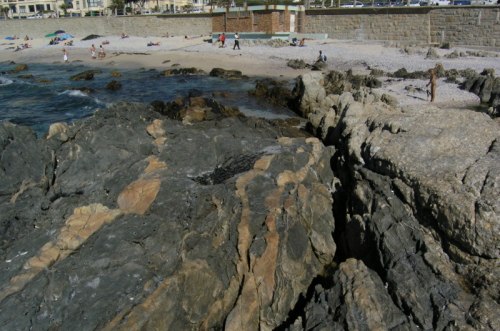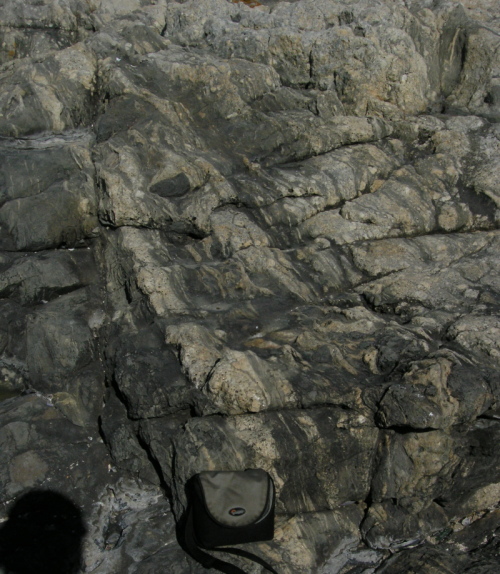In a previous installment, my intrepid wander along the Capetonian seafront ended at Seapoint, where slightly metamorphosed sediments of the Malmesbury group come into contact with the intrusive Cape Granite. In the photo I showed you then, the contact appeared to be fairly sharp.

However, if you look closely at the foreground of the photo above, you can see lenses of much darker material within the pale granite. These are actually bits of the Malmesbury Group sediments, completely surrounded, and incorporated within, the granite. The contact at Seapoint is actually anything but sharp; instead, over a hundred metres or so of the shoreline you can walk across a beautifully exposed example of a gradational contact. Starting on obvious outcrops of the Malmesbury group and heading east, first you see distinct veins of granite being intruded into the sediments:

then you enter an area where the stripes of intrusive granite become much more numerous, to the extent that they sometimes appear to take up more volume than the dark sediments that they are intruding.


Looking at a smaller scale, even the stripes of lighter granite and darker sediments are not entirely distinctive, with small fragments of granite, including some impressively large feldspar crystals, entirely isolated within the sediment stripes, and vice versa.

It is then, and only then, that you get into a “pure” granite; although this is clearly a contact between two rock units, where you actually draw the boundary between the intrusion and the intruded is a little arbitrary.
So why the complexity? As magma pushes intrudes into solid rock, it will do so by exploiting pre-existing weaknesses. Rocks like the Malmesbury Group are weak at the boundary between each bed, especially when these bedding surfaces have developed a slight cleavage; growth of new minerals on the bedding surfaces has increased the tendency for the rock to break along them. Thus the magma which formed the Cape Granite was able to break through at many points, leading to this interleaving of magma and the original rock at the edge of the main intrusion, which is where one particular fracture ended up as the main conduit for the intrusion (for more detail on the processes at work, check out Christie’s post about this contact).
But you just don’t have to take my word for it. My visit to Seapoint was motivated by historical as well as geological interest, because it was visited by none other than Charles Darwin almost 200 years ago during the voyage of the Beagle. His description appears on pages 149-150 of Geology of the Beagle, Part II*, which is available online:
The actual junction between the granitic and clay-slate districts, extends over a width of about 200 yards, and consists of irregular masses and of numerous dikes of granite, entangled and surrounded by the clay-slate: most of the dikes range in a N.W. and S.E. line, parallel to the cleavage of the slate. As we leave the junction, thin beds, and lastly, mere films of the altered clay-slate are seen, quite isolated, as if floating, in the coarsely-crystallized granite; but although completely detached, they all retain traces of the uniform N.W. and S.E. cleavage. This fact has been observed in other similar cases, and has been advanced by some eminent geologists, as a great difficulty on the ordinary theory, of granite having been injected whilst liquefied; but if we reflect on the probable state of the lower surface of a laminated mass, like clay-slate, after having been violently arched by a body of molten granite, we may conclude that it would be full of fissures parallel to the planes of cleavage; and that these would be filled with granite, so that wherever the fissures were close to each other, mere parting layers or wedges of the slate would depend into the granite. Should, therefore, the whole body of rock afterwards become worn down and denuded, the lower ends of these dependent masses or wedges of slate, would be left quite isolated in the granite; yet, they would retain their proper lines of cleavage, from having been united, whilst the granite was fluid, with a continuous covering of clay-slate.
This passage highlights one of the reasons that I admire Darwin so much: he was clearly a kick-ass geologist, with great observational powers and keen insight. It’s often forgotten in the wake of Origin of Species, but his scientific reputation during his lifetime was largely built on his work in geology: for example, his linkage of the rise of the Andes to the coastal uplift he observed following a large earthquake in Chile in 1835, or attributing the formation of atolls to the subsidence of volcanic islands. Here, he is contributing to a long-running geological debate over the origin of granites: at the time of his visit, some scientists were still arguing that granites were all ‘Primary’ – older than any other rocks – and precipitated from a global ocean at the dawn of time. Contacts like this, where the granite has clearly been injected into pre-existing sedimentary rocks, were key to overturning this school of thought. It’s quite a fun intellectual exercise to visit this prop for a long-settled geological debate, and ask yourself: if you didn’t “know” that the granite was intrusive, could you read the signs in the outcrop that convinced Darwin and his contemporaries that it was?
*More accurately, Geological observations on the volcanic islands visited during the voyage of H.M.S. Beagle, together with some brief notices of the geology of Australia and the Cape of Good Hope. Being the second part of the geology of the voyage of the Beagle, under the command of Capt. Fitzroy, R.N. during the years 1832 to 1836. Because that is more than a bit of a mouthful, it seems to be generally referred to merely as Volcanic Islands.



Comments (2)